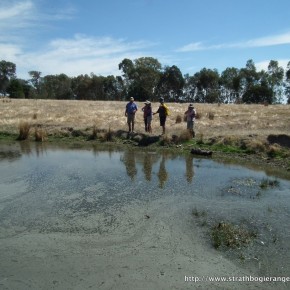 This project began in mid-2012 and is now gearing up for the first round of on-ground works. The project area covers the Swanpool and Warrenbayne-Boho Landcare districts, on the lower slopes and plains around the northern margins of the Strathbogie Ranges.
This project began in mid-2012 and is now gearing up for the first round of on-ground works. The project area covers the Swanpool and Warrenbayne-Boho Landcare districts, on the lower slopes and plains around the northern margins of the Strathbogie Ranges.
You can read more about the project sites on these pages.
The key to having a healthy, productive wetland, is habitat diversity and stock control, so fencing and revegetation (aquatic and terrestrial) are key components of this project. Once a pond or wetland has been fenced, aquatic and terrestrial vegetation will naturally start to grow back, but to speed up the process (we humans are impatient animals!) most of the project sites will also have plantings.
But we’re also looking at improving some of the wetland sites by creating shallow-water areas to slow run-off and allow water to pond during winter-spring, or after heavy rain, then to dry out over summer. This wetting and drying is an important part of wetland function and it’s where a lot of wetland biodiversity is concentrated. ….
And just to make sure our plans are achievable (within budget), we sought advice from an expert, someone that’s created and rehabilitated these sorts of wetlands before and can help us achieve our goals as effectively and efficiently as possible. We asked Damien Cook from Australian Ecosystems® and Rakali Consulting to tour the project sites with us and help us improve the draft plans where needed.
So, on Monday 11th March the Project Coordinators (Deb Hill and Deb Holmes) and myself (Bertram Lobert) were joined by Damien on a tour of several of the project wetland sites . At each site we walked the area, with the landowners where possible, and reviewed the site’s rehabilitation plans. Across all project sites rehabilitation activities include:
- Stock-proof fencing around the wetland/project site.
- Introducing logs and woody debris, for perching birds and aquatic habitat.
- Landscaping to slow water movement.
- Planting of a variety of plants, locally native to the area, including, water plants (eg. sedges, spike-rushes, water ribbons), thickets of shrubs for wet and dry areas, and trees at low density.
- Installation of nest-boxes for wildlife, if tree hollows are missing.
We examined each site with Damien, in light of the above list of actions, and had fruitful discussions about how best to proceed. In particular, Damien was able to help us visualize and design the landscaping, required at a few sites, that will create those important shallow-water areas. What became abundantly clear to all of us was that our Project Sites include a fantastic variety of ‘rural’ wetland types, that each have huge potential to become important biodiversity hot-spots.
Here are a few pics of our day.
